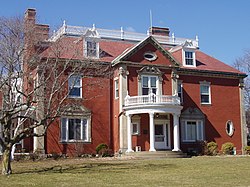Swampscott Town Hall
|
Elihu Thomson House
|
|

Elihu Thomson House
|
|
| Location | Swampscott, Massachusetts |
|---|---|
| Coordinates | 42°28′11″N 70°55′8″W / 42.46972°N 70.91889°WCoordinates: 42°28′11″N 70°55′8″W / 42.46972°N 70.91889°W |
| Area | less than one acre |
| Built | 1889 |
| Architect | James Kelley |
| Architectural style | Colonial Revival, Other |
| Part of | Olmsted Subdivision Historic District (#02000696) |
| NRHP Reference # | 76002002 |
| Significant dates | |
| Added to NRHP | January 7, 1976 |
| Designated NHL | January 7, 1976 |
| Designated CP | July 1, 2002 |
Swampscott Town Hall, previously the Elihu Thomson House, is a historic building at 22 Monument Avenue, Swampscott, Massachusetts. The house was designed by architect James Kelley and built in 1889 for the noted inventor, electrical engineer, and industrialist Elihu Thomson (1853-1937) who was, with Thomas Edison, co-founder of General Electric Company. The house was built with an observatory, which no longer exists. It has housed Swampscott town offices since 1944, when it was given to the town by Thomson's heirs. The building was declared a National Historic Landmark in 1976 for its association with Thomson.
Swampscott Town Hall is set on an expansive lot overlooking the town's soldiers memorial and Linscott Park in the town center. It is a two-story brick Georgian Revival structure with a tiled hip roof that is crowned by a low balustrade with turned balusters and urn-topped posts. The main facade is asymmetrically fenestrated, but there are symmetrically placed gable dormers in the roof, and the entrance is in a slightly off-center gable-topped projection. The building corners, as well as those of the entry section, have Ionic stone pilasters at the corners. The main entrance is sheltered by a round portico supported by fluted Corinthian columns, which supported an entablature with a carved frieze. The portico is topped by a balcony with a low railing slightly different from that on the roof. Above the entrance is a French door flanked by stone fluted Corinthian pilasters, and topped by a scrollwork pediment. Large windows on either side of the entrance on the first floor are topped by similar pediments.
Upon entry through the front door, there is a vestibule lit through stained-glass windows, followed by a panelled entry hall, which leads to a large two-story living space in the rear of the house, from which a grand staircase rises to the second floor. Pocket doors from these halls lead to what were formerly living and dining rooms at the front of the house, and there is a small guest bathroom immediately left of the vestibule in the front projection. A significant portion of the woodwork in the downstairs has been lost due the building's conversion for municipal use, but the living room, which now serves as the selectmen's office, and the central hall are largely intact. Also well-preserved is one of the children's bedrooms upstairs, which has a Moorish theme.
Behind the main house is Thomson's original carriage house, which was originally connected to the main house by a covered walkway, since replaced by an enclosed passage. This alteration resulted in the loss of a projecting bow window. Above the carriage house is a space that was used by Elihu Thomson as a laboratory.
...
Wikipedia


